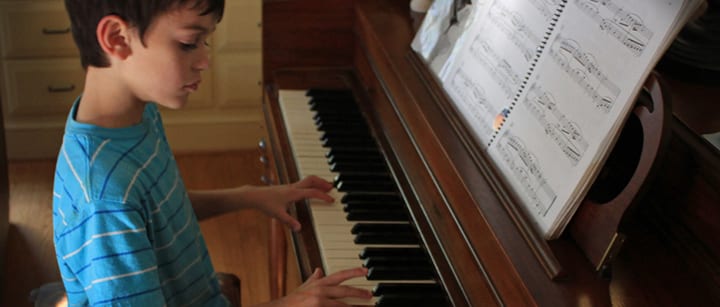 Is your son or daughter excited about starting piano lessons? Learning a new skill can be both fun and nerve-wracking. So as a parent, what can you do to ensure his or her success? Here, Rosedale, MD teacher Theresa D. offers her tips…
Is your son or daughter excited about starting piano lessons? Learning a new skill can be both fun and nerve-wracking. So as a parent, what can you do to ensure his or her success? Here, Rosedale, MD teacher Theresa D. offers her tips…
Many parents want to do as much for their child as they possibly can, while other parents want to let their child figure it out on his or her own. But how much is too much help, and how much is not enough, when it comes to piano lessons for kids? Well, I am going to try to help you figure that out.
Ask Questions
Every child has different learning styles and needs. For instance, one might need more help with playing and practicing, while another might be more personally motivated and does not need much support. You need to talk to your child to find out what he or she needs. For younger students, you may need to keep it simple. Start a discussion after the first lesson, and ask questions like “How did it make you feel?” and “Did you enjoy your lesson?” This gives you an idea if the teacher or teaching style is the right match for your child.
Also, ask your child if he or she wants you in the room during the lessons. With younger students, I highly encourage parents to stay in the room as an observer. That way, you are able to help with practicing at home. Feel free to take notes or ask the teacher to email the information after the lesson is over.
Encourage Consistency
It is very important for your child to take lessons and practice regularly. It holds your child accountable and will help him or her stay motivated. If you have to miss lessons or practice, try to make up for it at a later date or the next day if possible.
Set a Practice Schedule
Practice is the most important step to success. But it doesn’t have to take up hours and hours every night. I usually recommend at least one hour a week of practice. For those with shorter attention spans, breaking it up into smaller times can make practice more enjoyable. For example: 10 minutes for six days or 15 minutes for four days. This allows the student to focus on what he or she is practicing and actually make progress. If your child wants to practice longer, then that’s fine.
Practice should also be scheduled. Just like written homework from school, it should have a specific time to be done on a regular basis. Some suggestions for practice times could be right after homework is done for school, while dinner is being prepared, before bed, or first thing in the morning.
Help Out During Practice
For students that have issues with looking down at their hands while playing, keeping track of where they are in the music can be difficult. One way to help is to cover your child’s hands with a folder held a few inches above the fingers. This forces your child to keep his or her eyes on the music and trust his or her fingers. Other students may need more help, so here is another idea to try: point to the notes on the music as he or she is playing. That way, if your child does need to look down, it’s easier to find the spot in the music faster.
If your child has problems reading music or identifying the notes, have him or her say the letter names out loud before or while playing the music. This will help your child recognize the notes more quickly, and is better than writing in the notes, as that can cause dependency on the letters and not the actual music notes. However, students may write some notes in their music as a reminder. Encourage the use of a colored pencils for this, instead of a regular pencil. It makes it easier to see the notes written in the music and it allows them to show their personalities, even if they are the only one to see it.
If your child is old enough, make sure he or she has a piece of paper nearby to take notes during practice. Encourage your child to write down any questions that come up during practice so he or she can ask them at the next lesson.
Finally, while it is important to keep things consistent, children also like exploring new things. For example, you could encourage your child to change the sounds or instruments on your keyboard. Most keyboards come with a variety of sounds to play with. Your child might like to try harpsichord, saxophone, or even animal sounds to make practicing more interesting.
Talk to Your Child’s Teacher
I understand that parents don’t really have a say in what the teacher wants to teach, but as a parent you can influence the direction the teacher will take. If you notice that your child hates practicing or is unhappy after each lesson but is still making progress, maybe the music choice is off or there needs to be a change to the practicing routine. Let his or her teacher know. After all, teachers cannot read minds. Sometimes it only takes one song to get your child excited about playing again. Also, if you and your child are confused about an assignment, don’t be afraid to talk to your teacher. Some teachers will be available for questions between lessons through email, phone, or Skype.
Most of all, you need to keep your eyes and ears open to the signs that your child is giving off. Be an active participant in their music education.
Theresa D. teaches piano, guitar, percussion, and more in Rosedale, MD. She has been teaching for the past 18 years. Learn more about Theresa here!
Photo by woodleywonderworks
Suzy S.


